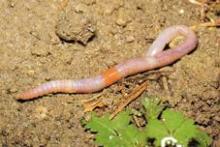living soil
The upper layer of the earth's crust is the living space for a variety of organisms.
One gramme of soil contains milliards of micro-organisms, i.e. bacteria, fungi, algae and protozoa, and below one square metre of soil there live hundreds of thousands up to millions of soil animals, such as threadworms, earth worms, mites, isopods, springtails and insect larvae. Reckoned on the basis of one hectare, this amounts to 15 tons of living weight, which corresponds to about 20 cows. There live considerably more organisms there than upon the soil.
These organisms are adapted to the conditions prevailing in the soils. Life in the soil is only possible in hollow space, which is filled with water or air. Small organisms rely on existing pores, larger ones dig their own holes. The soil organisms form close living communities, the composition of which depends on the qualities of the soil and of its use. For instance, in sour soils there are more fungi, whilst in neutral soils bacteria dominate, and soil with grassland utilization contain more organisms than fields.
In a complicated chain of food bacteria, fungi and soil organisms decompose organic substances and create new substances. Worms, isopods, mites, springtails and insect larvae break up the mulch - e.g. leaves or straw - and mix the material with the soil. Thereby they loosen the soil, they form stable crumbs of earth, they further aeration and increase the capacity to retain water. Earth worms, for instance, move up to twelve kilogrammes of earth per year in one square metre of soil. The actual decomposition of the mulch is effected by the bacteria and fungi of the soil. The largest part of organic substances is transformed, by a gain of energy, into carbon dioxide and water. The rest turns into the humic material. These dark substances improve the capacity of the soil to retain water and increase its capacity to store nutriments and pollutants.
They stabilize the soil aggregates and further the heating of the soil. When the mulch is decomposed, also the nutriments bound to the plant material are transformed into simple anorganic compounds, which can again be absorbed by the roots. The decomposition of mulch is therefore one of the most important achievements of the soil organisms.
The speed of decomposing mulch depends on the climate, on the type of vegetation and the qualities of the soils. In central European forests, five to seven tons of mulch accumulate per hectare and year.
Under favorable conditions, the soil organisms nearly completely decompose this quantity.
If the conditions are not favorable, however, such as in low-nutriment soils below coniferous forest, the decomposition of organic material is effected more slowly. The consequence is that up to some decimetres of mulch layers are formed.
Beside the mulch, the micro-organisms of the soil are also able to decompose organic pollutants, such as e.g. mineral oils and pesticides. This capacity is also known as the self-purification capacity of the soils and used for their rehabilitation.
Apart from this, some micro-organisms have the capacity to transform nitrogen from the air into organic nitrogen compounds. For instance, nodule bacteria of the genus rhizobia, which live in a symbiosis with plants of the pea family, such as clover, bean or lucerne, bind more than 300 kilogrammes of nitrogen per hectare and year. As a comparison:
Wheat withdraws from the soil per hectare and year about 150 kilogrammes of nitrogen. The ecological cultivation can therefore by a purposeful cultivation of plants of the pea family completely refrain from using nitrogen-enriched mineral fertilizers.
A very close relation also exists between fungi of the soil and more sophisticated plants, which is partly already expressed in the designation of the fungi (e.g. shaggy boletus). This symbiosis is called mykorrhiza. Thereby, the fungi form a further netting at the rooting of the plants and thereby increase the area of contact with the soil. On account of their small diamter they penetrate into even finer pores of the soil and thus provide water and nutriments for the plants (especially phosphor).
04.11.2025
EUSDR PA10: 12th Danube Participation Day in Sarajevo
more ...30.10.2025
Online-Präsentation BBK-Projekt CNSoil - Zwischenergebnisse
more ...07.10.2025
CatchHedge - Potenziale von Hecken im Zeichen des Klimawandels
more ...16.+17.09.2025
32nd Conference of the Danube Region
more ...12.09.2025
Grundlagen der professionellen Bio-Mandel-Produktion
more ...10.09.2025
Agroforst u. Marktgärtnerei, Symbiose
more ...05.09.2025
Regionales Wiesensaatgut gewinnen mit dem Wiesensamenernter
more ...25.06.2025
Feldtag - StripTill im Bio-Mais im Trockengebiet
more ...25.06.2025
Seminar: Wildbienen- und Nützlingsförderung im Biolandbau
more ...24.06.2025
BOKU Green Plate Forum 3.0
more ...24.06.2025
Die Maulbeere - Kultur, Produktion u.Verwendung
more ...17.06.2025
Frühjahrstagung Österr. Gesellschaft für Agrar- und Umweltrecht (ÖGAUR)
more ...13.06.2025
Seminar: Artenvielfalt in Ackerbauregionen fördern
more ...03.06.2025
Seminar: Keine Angst vor der Ackerdistel
more ...03.06.2025
Agroforstsysteme: Anbau-Modelle der Zukunft
more ...20.05.2025
IDM-Generalversammlung 2025
more ...15.05.2025
Seminar: Unkräuter/Beikräuter erkennen und als Zeigerpflanzen nutzen
more ...13.+14.05.2025
Bodenforum Österreich - Frühjahrstreffen
more ...04.05.2025
Tageskurs: Perma-Veggies - Mehrjähriges Gemüse und essbare Stauden
more ...03.05.2025
Waldgärten-Exkursion
more ...



